More and more companies are moving to a hybrid working model, with some employees working remotely and some remaining onsite. Since the lockdown over half of the UK’s workforce has been working from home in some form or another.
Hybrid working has been around for some time, especially in the tech industry. Employees whose work can be done from anywhere have pushed for options that allow them to reduce their commute, and maintain other commitments around their workday. Pre-pandemic, Statista’s data shows that 4.61m people worked from home in 2019, with 8.06m part-time workers.
Even with this in mind, there has been a huge shift to remote working due to the coronavirus pandemic. Companies are finding it difficult to decide when or how often staff should visit the office, adapting their approach according to government advice which changes all the time.
“The idea of putting 7000 people in a building may be a thing of the past.”
Jes Staley, head of Barclays
For the time being, hybrid working is a current reality – and many companies are suggesting that a hybrid model will be the future.

What are online workspaces?
As the name suggests, online workspaces are virtual centralised environments that can be accessed via the internet by groups of users that require access to the same content. They provide a place for employees to collaborate and communicate both with each other and with clients. Online workspaces offer a way to manage any number of projects efficiently at the same time or asynchronously.
Over recent years online workspaces have increased in numbers. Like video conferencing apps, they’ve improved, offering more effective tools, better customer support, safe file storage and faster data availability.
Workspace widgets have become invaluable for businesses regardless of their industry. They can eliminate geographic barriers, enable hybrid working, and help employees work ‘on the go’. Regardless of their device or location, employees can share files, exchange ideas, and get their work done.
There are two types of workspace: public and private. Public workspaces are available for everyone within the organisation to join whereas private workspaces cannot be accessed without an invite – so members must be granted permission before joining.

What are the key features of an online workspace?
1. Availability of real-time activity streams
Workspaces can provide live activity streams that can be seen by all members of a workspace in real-time. Team members can see who had made a change, to which content, and when the content was changed. For example, everyone can immediately see if a team member has uploaded a new version of a report or added an event to the calendar.
2. Collaboration and communication
Using powerful collaboration features, entire departments can access an online workspace. And These allow team members to share their opinions, information and updates with others, synchronously from anywhere and at any time. Workspaces are the perfect place to share announcements, contribute to team discussions, and ensure everyone is up to date on projects’ progress. Means of communication include video calls, team messaging, and company-wide threads.
3. Document management
Online workspaces are the ideal places to get documents signed off quickly and efficiently. They’re also important for keeping track of feedback and making updates transparent between team members. Files can be locked (version-controlled) whilst changes are being made, so everyone always has access to the latest version of a file.

4. Project management
Just as they are on a company intranet, everyone can be kept in the loop about department tasks and events in a virtual workspace. Projects can be assigned either to the individual or team members as a whole. It’s also possible to set up workspaces for individual projects, such as designing a new product and business-wide communications. You should expect:
- Custom task lists – team and individual
- Instant messaging
- The ability to assign tasks to other team members
- Recurring and one-off reminders
- API Integration with other apps
5. Ability to set secure access permissions
Online workspaces are secure and offer a range of solutions up to bank-grade security/SSL encryption for accessing content. Additional measures may include two-factor authentication, automatic sign-outs, complex passwords, and more, depending on the business’s nature and requirements.
6. Member Directory for easy communication
Rather than keeping a separate list of contact details for your team, you should be able to look them up on a member directory. This will list everyone currently in the workspace, potentially with status details (such as online, in a meeting, or on holiday). It’s a great way to speed up communication, as well as ensuring no-one misses anything important.
7. User dashboards
Many online workspaces have the option to create custom user dashboards. This way, individual users can see what’s most relevant to them. This could be particular chat threads, to-do lists, or direct messages.
8. Integration with other software
Rather than being a stand-alone piece of software, a good online workspace should integrate with the other tools you use. This allows teams to manage all of their work through the same platform, rather than switch between programs. Some common integrations include GitHub, Google Drive, social media platforms, and Salesforce.
How do online workspaces support a hybrid workforce?
Online workspaces support employees working in a hybrid model in countless ways, including:
Streamlining task management
Online workspaces make managing projects easier for a hybrid workforce with the ability to set tasks for the appropriate team members – or clients – once they’re a member of that workspace. There’s no need to be in the same physical space to see who is responsible for which task and when it needs to be completed by.
Enables team camaraderie
Threaded discussions, similar to social media posts can be used within a workspace where employees can like or mention other colleagues. This can help remote, and office employees work together more easily. By initiating group chats and discussions, hybrid teams can develop increased camaraderie and work more effectively together.

Keeps hybrid workers on the same page
Within a workspace, experts can work together and share their knowledge no matter where they are working or what time of day. Co-workers can exchange ideas, create wikis, Gantt charts, and develop solutions in real-time, helping the business move forward.
Keeps data secure whilst working remotely
Online collaborative workspaces can help hybrid co-workers maintain a safe place to store files and keep them safe from risks of theft of a computer or hard drive malfunction. This functionality ensures data is not lost. Since all data is kept in the cloud, it can be accessed no matter what happens to the hardware.
Examples of online workspaces
There are many examples of free online workspaces available offering task and project management, calendars, file storage and document management 24/7.
1. RingCentral
RingCentral Office is an online team collaboration tool designed to simplify communication between coworkers and different teams, whether working together in an office, entirely remotely or a hybrid. Team members can communicate directly as well as in group chats. The app is available on the desktop, as well as on iOS and Android.

RingCentral also offers Glip, with a dedicated range of task management features. There is a free version that includes unlimited meetings, integrations with Google Workspace and Microsoft 365, and file sharing. The pro+ version offers increased functionality with advanced analytics, delegate scheduling and 24-hour support.
2. Chanty
Chanty is a business messenger that enables seamless collaboration powered by AI. It helps teams become more productive with instant messaging, unlimited search history, file sharing and united notifications. The AI algorithm predicts responses when team members are typing, thereby saving time, while workflow functionalities bring structure to conversations enabling users to coordinate tasks efficiently.
Chanty costs $3 per user per month for which users get unlimited private and public conversations, voice messages, roles and permissions, unlimited integrations and up to 20GB storage per user.
3. Flock
Flock is an all-in-one messaging and online collaboration tool built for smaller businesses. Teams can exchange messages, share files, manage tasks and enjoy centralised access to multiple business tools and services. It offers customizable channels and a team directory feature.
Powerful search features mean users can quickly find anything from a message to a file or link. Shared ‘to do’s, note sharing and reminders also help to optimise project -management. A 30-day free trial is available.
4. Crew
This mobile-first app helps companies streamline communications across widely dispersed teams. The crew gives teams access to information and team discussions with the state of the art compliance controls, dependencies, advanced integrations, tools, templates, and a modern messaging platform.

Crew’s advanced analytics let you track schedules, monitor key engagement metrics in real-time and keep track of team-level conversions and feedback. The basic plan is free for one organisation and up to 35 users. You can then select add-ons and extra support as required.
5. Trello
Trello helps teams work collaboratively using boards, lists and cards for organising and prioritising projects. Team members can get information at a glance and add comments and due dates and use Trello cards to collaborate on projects end-to-end.
Built-in automated features boost productivity by removing certain manual tasks while the software integrates with many third-party mobile apps to meet individual business requirements. Trello ensures teams are in sync no matter where and what device they are on. Sign up is free.
6. Dropbox
Dropbox is a smart workspace plugin, where teams, online collaboration tools and content combine. It enables creating and storing shared cloud content from Google docs, sheets and slides to Office files and Dropbox Paper files. The software brings files together and integrates with many third-party apps, such as Trello, to enable hybrid teams to work together.

Pricing varies according to business needs, but standard plans start at £12 per month for 3 users with unlimited space. You can also try DropBox for free for 30 days.
7. Monday
Monday is a project management app that enables teams to manage multiple projects simultaneously, no matter where they are located. It provides a one-stop solution for project management, email, reporting, planning and CRM. In a shared online workspace, teams can assign tasks, get notifications, and work in real-time.
Users can get a broad view of the team’s work and understand performance to ensure everyone is on track. Monday is easy to integrate with existing tools including calendars and spreadsheets, meaning all work is kept in one centralised workspace. The basic plan is £21 per month for unlimited users, 24/7 support and 5 GB of storage.
8. Basecamp
Basecamp is an all-in-one remote toolkit that enables teams to work together more productively. Work is broken up into projects where everything needed to complete that project is kept in one place – from people and discussions to documents, tasks and important dates. Teams have access to message boards, ‘to do’s’, schedules, group chats and automatic check-ins.

Basecamp’s ‘my stuff’ lets users see everything from their assignments and schedules to bookmarks and project activity. At $99 per month, Basecamp might be a bit pricey, but you can test it for free for 30 days.
9. LiquidPlanner
LiquidPlanner is designed for fast-moving teams. Using three inputs – priority, ranged estimates and availability – project schedules are always real-time with a smart schedule feature that helps you account for best and worst-case scenarios.
LiquidPlanner allows you to see how much work a team member has done and get instant insight into progress, risks and budgets for all projects. You can request a free trial – after which professional users pay $45 per user per month.
10. Glasscubes
Glasscubes offers secure online workspaces for team collaboration along with tools that enable efficient project-management. The software allows teams to store and share files securely and set up an approval workflow.
Customised dashboards allow team members to view announcements and see the latest activities, posts and completed tasks. High priority announcements can be pinned to the dashboard for continuous viewing. Threaded discussions and calendars are other useful features aimed at team collaboration. Glasscubes can be trialled for free.
Conclusion
Hybrid working has grown to play a big part in the working model mix. Post pandemic, hybrid work will undoubtedly have earned a permanent place in the majority of companies’ employment model.
When done correctly, hybrid models offer better opportunities for employers in hiring better talent and for employees who can enjoy the benefits of flexible working. A key element of managing this new type of workforce lies ineffective communication.
To succeed, businesses need to adopt the right digital systems. Online workspaces need to be:
- Easy to integrate with other apps
- Cost-effective
- Customisable to individual’s needs
- Accessible from anywhere
Investing in a smart online workspace can improve communication between employees, giving them greater flexibility in where and how they do their work. Many of these tools offer a free trial, making sure you can find the right app for you.
Originally published Feb 22, 2021, updated Jan 16, 2023



